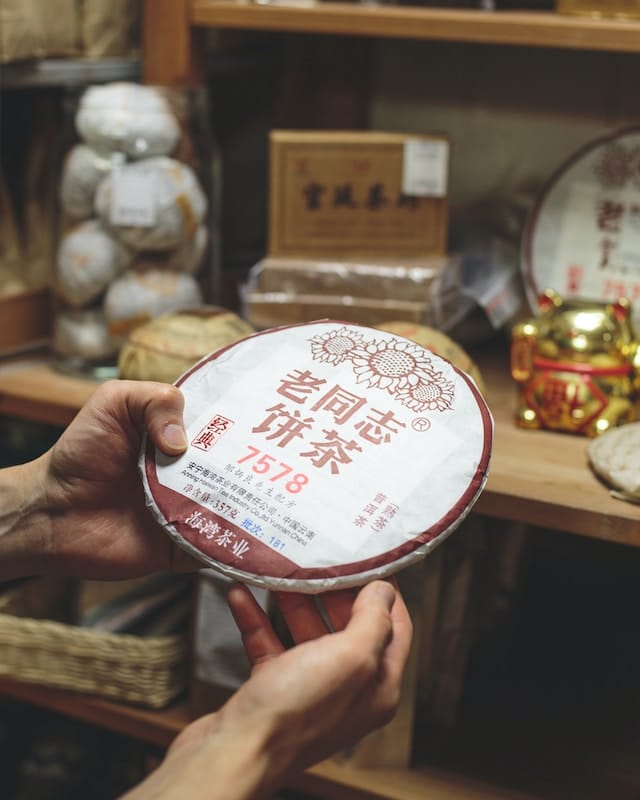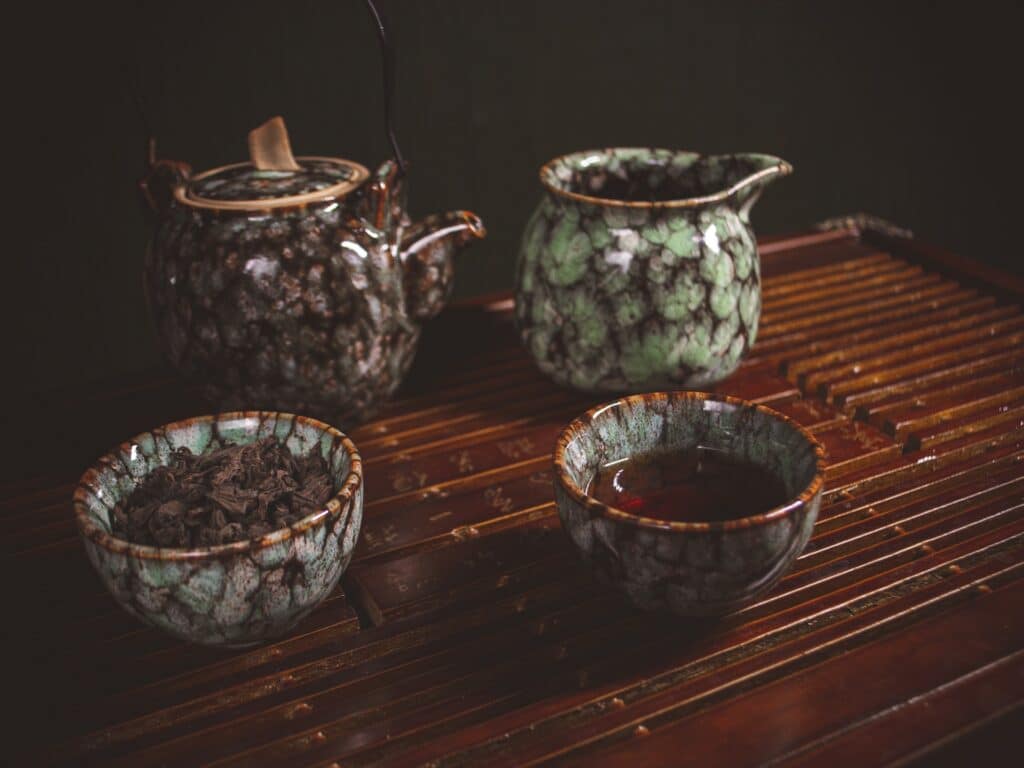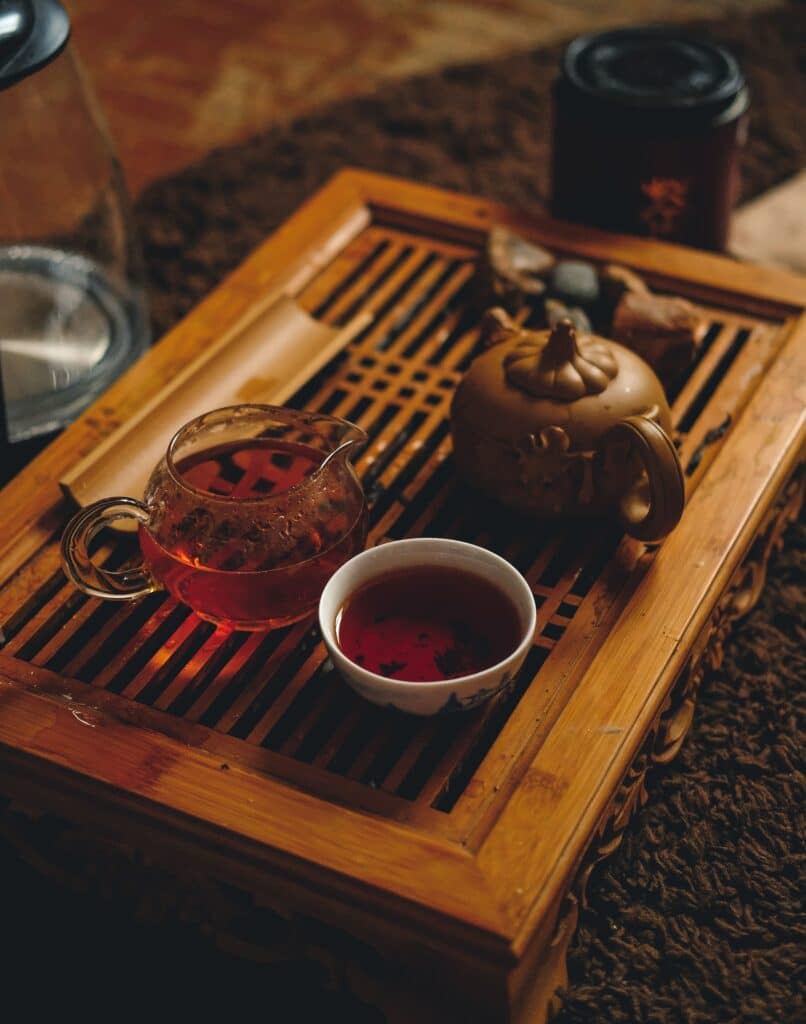Brewing pu-erh tea the traditional way is challenging. The tea-making technique is also as complex as the history of this tea.
To brew Pu Erh tea, boil water to 195–205°F, place 1-2 teaspoons of tea leaves in a teapot or infuser, pour hot water over the tea, let it steep for 3-5 minutes, and then pour the tea into a cup. It can be steeped multiple times, and the brewing time can be adjusted.
That was the short version; now let’s dive into the details:
Where Did It Come From?
Pu-erh tea is an oxidized tea that has always been made mainly in the Yunnan province of China. For the tea to acquire distinct flavor properties, it must age for many years. To get ripe pu-erh, you must process the tea cakes flawlessly.
The big leaves of the Camellia sinensis tea plant make pu-erh tea, a genuine tea. The Assamica tea plant is the most popular tea plant that makes pu-erh tea. After being collected, the leaves are divided into different types of pu-erh tea.
Pu-erh teas come in two varieties:
- Ripe pu erh (Shou)
- Raw pu erh (Sheng).
Green tea leaves are collected, processed, sun-dried, and fermented before being compressed into cakes and big balls to make raw pu-erh. These same tea cakes are then matured to enhance their taste.
Pu-erh tea differs from oolong tea and black tea in that the microbes, rather than leaf enzymes, are responsible for oxidation. Shai qing mao cha is the pu-erh tea’s manufacturing method.

Ripe Pu Erh Tea
Ripe pu-erh tea usually has a deeper brown color that looks reddish or dark chestnut. The earthy taste and potent fragrance of shou pu-erh tea are bold.
Raw Pu Erh Tea
When brewed, raw pu-erh tea becomes lighter and is typically a vibrant yellow. When you dry the leaves, they appear dark green instead of brown. They occasionally have stripes and frequently have white and brown ends. Sheng pu-erh tea has a mild depth of flavor and a slightly sweet aftertaste.
Brew Pu Erh Tea the Right Way
Pu-erh, which comes in ripe and unripe varieties, provides an exceptional tea experience. The Pu-erh that is most common is matured and seasoned over time. You won’t find another tea that’s equally rich, full-bodied, complicated, and elegantly smooth. The delicate and silky raw Pu-erh, only available in cakes, has a slightly sweet finish in contradiction to this intense flavor.
Brewing Ripe Cakes
- Boil your water in a Yixing teapot.
- Or boil some water in a cup, then empty the water. You can accomplish this by filling a teapot with water and then filling your cups with water from the teapot.
- Now you must add 8 to 10 ozs of water straight to the teapot with the leaves in it.
- Give the greens five minutes to steep.
- After this same passage of five minutes, pour the tea over a mesh sieve so that any remaining leaves will fall into the strainer.
- Serve the teapot’s liquid in your best tea cups and take a sip. Don’t let the tea in your teapot brew any longer.
Brewing Raw Cakes
Use cooler water and a brief steep time to avoid turning the delicate and smooth raw Pu-erh tea into a sharp and bitter beverage. Instead, handle it like green or white tea. Add one spoonful of the pu-erh cake and infuse for 3 minutes in purified, filtered water at almost 190°F. Throw the leaves away and enjoy.

Drinking Pu Erh Tea
Before we mention the best method of drinking pu-erh tea, we believe you would love to know the following fact:
Due to pu-erh tea’s high antioxidant and vitamin C content, consuming a cup of this beverage each day can help ward off sicknesses like the flu and the common cold. Pu-erh tea undergoes fermentation. Therefore, it contains more antioxidants than beverages that have not undergone fermentation.
Different studies mention the importance of pu-erh tea. Therefore, we must say that having a cup of this tea once a week will change your life. But to upgrade your experience, preparing pu-erh tea is as essential as serving it.
So when you serve pu-erh tea, ensure that your tea pitcher, kettle, cup, and other things give off great vibes. This fermented tea is best served using Yixing teapots. No one is sure as to why such teapots enhance the taste. But since they do something, it is better to use them.
The Method of the Mother
Any pu-erh brewing guide is incomplete without mentioning the traditional Chinese method. We all know that the Chinese are experts at making their tea. In other words, they take as good care of their tea as we do our wines.
Pu-erh tea goes through a complicated process that gives the person who drinks it a better understanding of Chinese culture and tea traditions. We recommend that people who want to learn more about tea and get involved with their heritage use this method. It’s a technique best adapted to expert brewers and tea lovers. You will require a Yixing tea set to achieve the best outcomes.
What You Need
To prepare pu-erh tea, you will require the following ingredients:
- Tea knife (to break the tea cakes)
- Pu erh tea/pu erh leaves (3 to 5 grams)
- Tea infuser
- Hot water
- Teacups
- Serving pitcher
This is everything you will need to bring out your inner tea connoisseur.
Brewing
- Use boiling water to rinse and heat the tea set. Pour the boiling water straight into the tea cups, Yixing pot, as well as the tea pitcher. Stir the water, then throw it away.
- Add some boiling water to the Yixing teapot with the tea leaves inside. The leaves should only be covered with water. After a couple of seconds to three of swirling, drain the water. Keep the wet tea stems in your cup.
- Repeat rinsing the wet tea leaves with water if you’re making ripe pu-erh tea. If you are brewing raw pu-erh tea, you only need to rinse it once; proceed to the next stage instead.
- The water on the cover should be dry after 10 to 20 seconds. Pour the tea into the tea glasses after the lid has dried. Relish!
Our Method of Brewing Pu Erh Tea
Since we are Americans, we love to bring out our versions of everything. Whether it is boba tea, burgers, pizza, and whatnot, we love to give it the Western touch. This method of brewing pu-erh tea is slightly easy. Although the tea tastes the same, the tea scoop we use here differs.
You won’t get dark tea using this method, as in the traditional way. However, your tea table will still look nice and warm. Most pu-erh tea leaves require a short steeping time. Enough with the talk; let us start preparing our tea.

What You Need
Now you won’t need that fancy Yixing pot for this method. Moreover, serving tea will become easy. So note the following list of pu-erh tea ingredients and tea tools:
- Pu erh tea (3 to 5 grams)
- Teapot (large)
- Tea kettle
- Tea filter
- Tea scoop
Preparation Stage
- To measure the ideal amount of loose-leaf tea, use the tea scoop. For every 8 ounces of water, take 3 to 5 g of compressed pu-erh tea from a pu-erh tea cake using a tiny pick or tea knife.
- Use a tea strainer/infuser to hold the pu-erh tea. You may utilize a regular kettle, pincer, or tea basket with an attached infuser.
- With a little hot water, rinse the pu-erh stems. After giving the leaves a final swirl in the boiling water, drain them.
- You must heat the water to 195 ℉ in a tea kettle or on any heat source.
- Now add the boiling water.
- Place the tea infuser containing the leaves in the teacup.
- It is better to avoid boiling water. Why? Because it may burn and produce a sour taste in tea. So your water temperature must not exceed 200 F.
- Pu-erh tea typically needs between two and four minutes to brew. Test every 30 seconds during the minutes of brewing to determine your favorite flavor.
- Once done, pour tea for yourself.
What do Pu Erh Tea Leaves Smell Like?
Pu-erh tea leaves smell like any other green tea leaf. However, there is an addition of a few floral and earthy notes. Both types of pu-erh tea leaves smell the same. But quality teas have their own vibe and texture.
To determine a good quality tea, smell the leaves and check if the floral notes are stronger than the earthy notes. If the latter is the case, the tea leaves are perfect.
Benefits of Pu-Erh Tea
Pu-erh tea has many benefits, especially if you use the traditional Chinese method for brewing. Your tea will be rich in antioxidants. In short, you can get the following benefits from pu-erh tea:
- Helps get rid of bloating
- Provides ease during the menstrual cycle
- Reduces inflammation
- Regulates normal blood pressure
Check out: Can You Put Milk in Green Tea?
Conclusion
Pu-erh tea has great roots in the history of many generations. Apart from its intense taste, pu-erh tea has several health benefits. Although the tea is on the pricey end, the taste and awesomeness it provides are on another level.
Whether using western or traditional methods, you will get the best taste possible.

